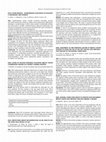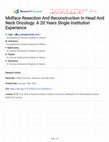Papers by Foteini Neamonitou

Archives of plastic surgery, Apr 15, 2024
Angiofibromas are a common facial manifestation of tuberous sclerosis (TS). However, current trea... more Angiofibromas are a common facial manifestation of tuberous sclerosis (TS). However, current treatments have proven ineffective due to high recurrence rates and noncompliance. To address this issue, we developed a new triple laser therapy protocol for more effective management of angiofibromas. We conducted tests to validate its efficacy. This is a prospective study of 10 patients with TS (4 women and 6 men, mean age 26.3 years [15-37 years]) with angiofibromata who received triple sequential laser therapy at our private dermatological clinic conducted from January 2000 to December 2022. We evaluated the outcome with the Facial Angiofibromata Severity Index (FASI) via clinical photography (0, 6 months, 1 year, and 2 years), and Dermatology Life Quality Index (DLQI). All patients had a successful recovery without any complications. Among these 10 patients, 4 experienced localized recurrences at their 6-month follow-up. These recurrences were treated with a second single carbon dioxide laser session. After 2 years of follow-up, we observed no recurring facial cutaneous manifestations. Furthermore, all patients experienced a decrease in their FASI score after treatment. According to the Visual Analogue Scale, patients reported 95% satisfaction, and DLQI indicated only a minor impact on their everyday lives. We believe that this protocol of three-step laser treatment is effective, safe, and compliable for patients with facial angiofibromata, providing a satisfactory outcome adaptable to the daily dermatological and plastic surgery practice.
Aesthetic Plastic Surgery, Jun 21, 2022

Ejso, Feb 1, 2020
Background: Partial breast reconstruction (PBR) with local perforator flaps for invasive and pre-... more Background: Partial breast reconstruction (PBR) with local perforator flaps for invasive and pre-invasive breast disease have expanded over the last two decades. As a result, the indications for breast conservation surgery (BCS) have been extended and mastectomy is avoided in selected patients with a high tumour to breast ratio. We report single-centre experience of partial breast reconstruction with local perforator pedicle flaps. Materials and Methods: Between September 2015 and January 2019, outcomes were prospectively recorded for all patients who underwent PBR with a local perforator flap at a single centre in the United Kingdom. All patients were discussed at the local multidisciplinary meeting and were deemed to have a predicted resection volume of >30% of breast tissue. Suitable patients were offered PBR with LICAP, MICAP, AICAP and TDAP flaps in order to avoid mastectomy. The procedures were performed by two surgeons and the clinicopathogical features, complications, and margin re-excision rates were recorded. Results: 61 patients had BCS and immediate partial breast with local perforator flaps over a period of 3 years and 4 months. The patients median age was 60 years (23 -73 years). Five of the patients had a > BMI 35 (8.2%) , 8.2% were diabetic and 1 was a smoker. 44 of the patients had screen detected disease and 17 had symptomatic disease. Invasive ductal cancer was predominant 47.5% and half of these patients with invasive ductal cancer had associated DCIS. 22.9% had DCIS only, 9.8% had invasive lobular cancer and 5% had mucinous carcinoma. The majority of the PBR were LICAP flaps 68.9%, 14.7% had MICAPs, 14.7% had ICAPs and 1.6% had both a LICAP and LTAP. The median hospital stay was 24 hours. Seven patient (11.5%) required re-operation to clear margins and one patient required reoperation for a haematoma. One patient reported a lateralised nipple resulting in poor cosmetic satisfaction . No other complaints were made about cosmesis. Conclusions: Chest wall perforator flaps allow a safe and reliable tissue transfer for partial breast reconstruction following wider local excisions. They are oncologically safe, have a low complication rate and provide good cosmetic outcomes.

JPRAS Open, Sep 1, 2019
Septoplasties and septorhinoplasties are common procedures in otolaryngology, aimed at addressing... more Septoplasties and septorhinoplasties are common procedures in otolaryngology, aimed at addressing septal and/or bony pyramidal deflections to improve functional and cosmetic outcomes. The nasal septum as well as regulating air flow provides structural support to the nasal tip. The attachment of the nasal septum to the anterior nasal spine must be structurally resilient to prevent saddling or tip ptosis. This can be achieved by direct attachment with absorbable suture material to the periosteum of the anterior nasal spine or a drill fitted with 0.6 mm diamond tip burr (Ultrabur, Invotec International), to create channel through which the nasal spine can be secured to the anterior nasal spine. We describe a novel, and cost-effective alternative utilising a blunt fill needle and simple absorbable suture. A blunt fill needle (Sol-Millenium®, cost £0.03 per unit) is passed through to form a securing channel. The neoseptum is then secured using a figure-of-eight suture. Our novel technique enables the nasal septum to be secured to the anterior nasal spine in a cost effective and efficient manner.

International Journal of Surgery, Jul 1, 2018
reconstruction with the same laterality, was then calculated and survival analysis performed. A t... more reconstruction with the same laterality, was then calculated and survival analysis performed. A total of 13,736 women were identified. Mean follow-up was 3.7 years. Overall 35.8% of women had further surgery 15% being secondary reconstruction, however differences were observed across groups. (Table ) Secondary autologous rates also varied. Women who underwent implant reconstruction had an increased relative risk and adjusted hazards ratio of 3.7 (95%CI:2.9e4.6) at 3 years comparative to women who received free flaps, p < 0.001. Our findings indicate a significant future workload following post-mastectomy immediate implant reconstruction comparative to autologous procedures. The rates reported can be used to inform patients and to assess quality of care across service providers. Further investigation of the financial implications of our findings are required.
Aesthetic Plastic Surgery

Core needle biopsy is being used for the diagnosis of breast masses and it is part of triple brea... more Core needle biopsy is being used for the diagnosis of breast masses and it is part of triple breast screening program in the UK. Generally, the most frequently encountered complication is hematoma. However, iatrogenic pseudoaneurysm is considered to be a potential but a rare complication. In this paper, we report a case of pseudoaneurysm occurring after a core needle biopsy in a breast lesion, part of the triple breast screening. A 51-year-old woman with no relevant medical history recalled from the breast screening program for a distortion in the upper outer quadrant of the right breast. The lesion was an X-5, P-1, U-5 with normal axilla and histologically grade 2 type Ca ER+ (Q=8 HER2-). The surgical management after the MDT meeting was a wire ultrasound guided wide local excision and sentinel lymph-node biopsy. On the day of surgery, the ultrasound scan -prior to wire guided localization procedure demonstrated findings suggestive of a pseudoaneurysm within the lesion and the wire...

Journal of B.U.ON. : official journal of the Balkan Union of Oncology, 2021
PURPOSE We sought to identify independent risk factors for positive sentinel lymph node biopsy (S... more PURPOSE We sought to identify independent risk factors for positive sentinel lymph node biopsy (SLNB), local recurrence (LR), metastasis (M) and death caused by cutaneous squamous cell carcinoma (cSCC) (DCS) in high-risk cSCC patients. Moreover, we compared the Brigham and Women's Hospital (BWH) system with the previous used in Greece (based on tumor size) and proposed a new classification system. METHODS 1,524 cSCC patients were enrolled between January 2004 and December 2014, from two medical institutions. Potential risk factors for SLNB (local recurrence/LR, metastasis/M, death caused by SCC/DCS) were analyzed by univariate and multivariate Cox logistic regression models. RESULTS Of the included patients with a median follow-up of 60 months 107 developed local recurrence (7%) while 84 developed metastases (5.5%). Among 36 patients undergoing sentinel lymph node biopsy (SLNB), 25% showed a positive SLNB with a false-negative result (11%). On multivariate analysis, key prognost...
Journal of Plastic, Reconstructive & Aesthetic Surgery, 2021

Archives of Plastic Surgery, 2020
Background Polyurethane implants have been used on and off in breast reconstruction since 1991 wh... more Background Polyurethane implants have been used on and off in breast reconstruction since 1991 while prepectoral breast reconstruction has gained popularity in recent times. In this study, we present our outcomes from the use of acellular dermal matrix (ADM) complete wrap with polyurethane implants in prepectoral breast reconstruction. Methods This is a retrospective review of prospectively maintained database from 41 patients receiving complete ADM wrap with prepectoral polyurethane implants over a 3-year period. Selection criteria were adapted from a previous study (4135 Trust Clinical Audit Database) evaluating prepectoral reconstruction with Braxon matrices. Patient demographics, operative data, surgical complications, and outcomes were collected and analyzed. Results A total of 52 implant reconstructions were performed in 41 patients with a mean follow-up of 14.3 months (range, 6–36 months). The overall reported complication rates including early (less than 6 weeks) and late co...

Annals of Plastic Surgery, 2021
Background Oncoplastic breast surgery is well established in many parts of the world and is gaini... more Background Oncoplastic breast surgery is well established in many parts of the world and is gaining popularity in the rest of the world. The cornerstone in oncoplastic breast surgery is to respect oncological principles during cancer resection maintaining good aesthetic and cosmetic outcome. With the advancement in local, regional, and systemic treatment for breast cancer, survival has improved, and patients live longer. It is utmost essential to help our patients to maintain a good quality of life. Aesthetic and cosmetic outcomes have a significant impact on patient's psychosocial, emotional, and sexual well-being. Oncoplastic techniques have evolved over the last decade with the increasing use of perforator flaps to enable partial breast reconstruction. We report the findings of a prospective cohort study using modified lateral intercostal artery perforator in partial breast reconstruction. This modified technique offers a less visible scar and good access to the axilla without any need for repositioning the patient during the operative procedure. Methods A retrospective review of a prospectively maintained database of patients who underwent partial breast reconstruction with a modified lateral intercostal artery perforator flap was carried out between July 2016 and January 2020 in 2 oncoplastic breast units. The study had local approval from the respective audit departments. Patient demographics, operative data, surgical complications, and outcomes were collected and analyzed. Results Forty-one patients underwent the procedure between July 2016 and January 2020. The median age of the population data was 58 years (interquartile range, 9 years). There were 10 active smokers (24.4%), and 3 patients had diabetes mellitus (7.3%). Overall, 3 patients (7.1%) developed seroma, 1 had a hematoma (2.4%), and 1 had a locoregional recurrence (2.4%). Two patients (4.9%) underwent margin re-excision for close margins. Most patients (92%) had the procedure carried out as day-case surgery. None of the patients developed wound infection, necrosis, or flap loss. The results were comparable across the 2 participating units. Conclusions The data suggest that modified intercostal artery perforator flap is an excellent oncoplastic technique for volume replacement in partial breast reconstruction with a short learning curve and minimal perioperative morbidity.
Clinical Breast Cancer, 2018
Abstract Involvement of axillary lymph nodes is an important prognostic factor in relationship to... more Abstract Involvement of axillary lymph nodes is an important prognostic factor in relationship to the management of breast cancer. However, the use of neoadjuvant systemic therapy is widespread in the treatment of positive axilla and such treatment leads to downstaging of axillary disease. Hence, the role of targeted axillary lymph node biopsy appears to play a vital role after primary systemic therapy. Given that this is a relatively novel approach, we have discussed the evidence for this approach and the different techniques currently available for localization of biopsy‐proven metastatic axillary lymph nodes. We have also highlighted the need for universal guidelines for conservative management of positive axilla after systemic therapy.

European Journal of Surgical Oncology, 2020
Background: Partial breast reconstruction (PBR) with local perforator flaps for invasive and pre-... more Background: Partial breast reconstruction (PBR) with local perforator flaps for invasive and pre-invasive breast disease have expanded over the last two decades. As a result, the indications for breast conservation surgery (BCS) have been extended and mastectomy is avoided in selected patients with a high tumour to breast ratio. We report single-centre experience of partial breast reconstruction with local perforator pedicle flaps. Materials and Methods: Between September 2015 and January 2019, outcomes were prospectively recorded for all patients who underwent PBR with a local perforator flap at a single centre in the United Kingdom. All patients were discussed at the local multidisciplinary meeting and were deemed to have a predicted resection volume of >30% of breast tissue. Suitable patients were offered PBR with LICAP, MICAP, AICAP and TDAP flaps in order to avoid mastectomy. The procedures were performed by two surgeons and the clinicopathogical features, complications, and margin re-excision rates were recorded. Results: 61 patients had BCS and immediate partial breast with local perforator flaps over a period of 3 years and 4 months. The patients median age was 60 years (23 -73 years). Five of the patients had a > BMI 35 (8.2%) , 8.2% were diabetic and 1 was a smoker. 44 of the patients had screen detected disease and 17 had symptomatic disease. Invasive ductal cancer was predominant 47.5% and half of these patients with invasive ductal cancer had associated DCIS. 22.9% had DCIS only, 9.8% had invasive lobular cancer and 5% had mucinous carcinoma. The majority of the PBR were LICAP flaps 68.9%, 14.7% had MICAPs, 14.7% had ICAPs and 1.6% had both a LICAP and LTAP. The median hospital stay was 24 hours. Seven patient (11.5%) required re-operation to clear margins and one patient required reoperation for a haematoma. One patient reported a lateralised nipple resulting in poor cosmetic satisfaction . No other complaints were made about cosmesis. Conclusions: Chest wall perforator flaps allow a safe and reliable tissue transfer for partial breast reconstruction following wider local excisions. They are oncologically safe, have a low complication rate and provide good cosmetic outcomes.

World Journal of Breast Cancer Research, 2017
Background: Evolution of meshes and implants available for breast reconstruction have led to an i... more Background: Evolution of meshes and implants available for breast reconstruction have led to an increase in the use of the prepectoral reconstruction technique, which is associated with superior clinical, aesthetic and cost outcomes when compared to the subpectoral method. In this paper, we describe our experience using a simple algorithm in prepectoral breast reconstruction, which can be adopted in clinical practice. We classified the breast into three categories according to size and ptosis. We applied the classification to 30 patients (10 random patient selection of each category) who underwent bilateral immediate prepectoral implant based breast reconstruction with ADM. The data was collected and statistically analyzed on SPSS. Results: Each category was tested with 10 bilateral cases, showed less complications in group 1 and 2. However, group 3 involved more complications that possibly caused of large volume breasts and high BMI. Our early experience demonstrates that first and second types are suitable for implant prepectoral breast reconstruction while the third type benefits with a dermal sling for additional support.

JPRAS Open, 2019
Septoplasties and septorhinoplasties are common procedures in otolaryngology, aimed at addressing... more Septoplasties and septorhinoplasties are common procedures in otolaryngology, aimed at addressing septal and/or bony pyramidal deflections to improve functional and cosmetic outcomes. The nasal septum as well as regulating air flow provides structural support to the nasal tip. The attachment of the nasal septum to the anterior nasal spine must be structurally resilient to prevent saddling or tip ptosis. This can be achieved by direct attachment with absorbable suture material to the periosteum of the anterior nasal spine or a drill fitted with 0.6 mm diamond tip burr (Ultrabur, Invotec International), to create channel through which the nasal spine can be secured to the anterior nasal spine. We describe a novel, and cost-effective alternative utilising a blunt fill needle and simple absorbable suture. A blunt fill needle (Sol-Millenium®, cost £0.03 per unit) is passed through to form a securing channel. The neoseptum is then secured using a figure-of-eight suture. Our novel technique enables the nasal septum to be secured to the anterior nasal spine in a cost effective and efficient manner.

International Journal of Surgery, 2018
Aim: Gynaecomastia causes include increased oestrogen activity, decreased testosterone activity, ... more Aim: Gynaecomastia causes include increased oestrogen activity, decreased testosterone activity, or taking certain medications. Although its aetiology is mostly benign, it often causes patients considerable anxiety, and assessment is variable. A detailed history, physical examination, and relevant investigations are necessary to determine the cause. Currently no certified standards exist for its management. The aim is to determine if the assessment of men referred with gynaecomastia meets BMJ Best Practice recommendations, and to improve/standardise management of the condition in our institution. Method: Retrospective audit involving 100 patients referred to the breast surgery clinic from March-August 2016. Result: 70% had non-physiological gynaecomastia, 59% of which were sent for imaging. Of these, 6% had tissue biopsy performed. Blood tests requested in 37% of patients. 56% did not undergo testicular examination. Pharmacological gynaecomastia was the commonest cause (63%). Most patients were discharged (92%) with only 2% found to have an organic disease as cause resulting in referral to other specialties. The evaluation of gynecomastia is complex and currently lacks uniformity. Our audit demonstrated a haphazard approach to its management. A standardised proforma, including detailed history, examination, imaging and laboratory testing, excludingneoplasms and endocrinopathies, could ensure appropriate patient assessment, and streamline care pathways.

European Journal of Surgical Oncology (EJSO), 2017
reconstruction with the same laterality, was then calculated and survival analysis performed. A t... more reconstruction with the same laterality, was then calculated and survival analysis performed. A total of 13,736 women were identified. Mean follow-up was 3.7 years. Overall 35.8% of women had further surgery 15% being secondary reconstruction, however differences were observed across groups. (Table ) Secondary autologous rates also varied. Women who underwent implant reconstruction had an increased relative risk and adjusted hazards ratio of 3.7 (95%CI:2.9e4.6) at 3 years comparative to women who received free flaps, p < 0.001. Our findings indicate a significant future workload following post-mastectomy immediate implant reconstruction comparative to autologous procedures. The rates reported can be used to inform patients and to assess quality of care across service providers. Further investigation of the financial implications of our findings are required.

Cureus, Jan 15, 2024
Facial palsy detrimentally impacts an individual's quality of life due to its effects on function... more Facial palsy detrimentally impacts an individual's quality of life due to its effects on function and appearance. There are several reconstructive surgical techniques available that aim to restore facial symmetry. Techniques such as direct neurorrhaphy, nerve grafts, dual reanimation, and reinnervation have the potential to enable varying motor functions, including the re-establishment of a dynamic smile. This study aimed to assess the outcomes of facial palsy reconstructive surgeries undertaken at a tertiary care centre for facial nerve reconstruction in Athens. This study consisted of a comprehensive case series showcasing the outcomes of facial palsy reconstructive surgeries on 29 patients at our Tertiary General Oncological Anti-Cancer Hospital of Athens 'Agios Savvas'. The surgical procedures from October 2004 to December 2023 included reinnervation, nerve grafting, free muscle transfer, and myoplasties following our recommended algorithm. We categorized the patients into two groups: Group A and Group B based on the timing of the reconstruction: delayed or immediate. The House-Brackmann grading scale evaluated the degree and improvement of facial paralysis. In Group A, two of the seven patients exhibited activation of the mimetic musculature immediately postsurgery, while the remaining five experienced enhanced facial nerve function in the subsequent months. Adverse outcomes were temporalis dysfunction in one case and tongue atrophy in another. Conversely, in Group B, 21 of 22 patients demonstrated facial activation immediately postsurgery. Only one patient from this group did not show any facial nerve function postoperatively. Two of the 22 patients in Group B encountered complications: one with trismus and another with temporalis dysfunction. All patients were observed for a minimum of 12 months postsurgery. With the exception of one patient, all participants showed improved postoperative results, which were satisfactory when weighed against the observed morbidity rate. While our case analysis did not reveal any clear indication of one particular technique being superior, the selection of methods should be based on several factors, and this algorithm could serve as a useful aid in that regard. A comprehensive and standardized clinical assessment of facial palsy, both before and after surgery, is crucial to establish a consensus and plan individualized therapy.

Background: Midface tumors are relatively uncommon as midface comprises less than 1% of all malig... more Background: Midface tumors are relatively uncommon as midface comprises less than 1% of all malignant tumors and incorporate a distinct group of lesions, with a high variety of histological types and biological behavior. The purpose of the study is to present our experience in managing patients with advanced midface tumors for a 20-year period.Materials & Methods: From January 2000 to May 2020, we performed 72 excisions and reconstructions in 36 patients where their medical records were reviewed by the head and neck oncology clinic. The commonest anatomical site of the primary was the maxilla in 19 patients and bilaterally in 5 patients. In 15 patients there was an orbital and anterior fossa extension. In 6 patients there was a parotid and middle ear extension and in 1 patient there was a lip involvement.Results: Surgical resection included maxillectomy in the majority of the cases in combination with orbital exenteration or orbitectomy and anterior fossa resection. In 8 cases parot...











Uploads
Papers by Foteini Neamonitou